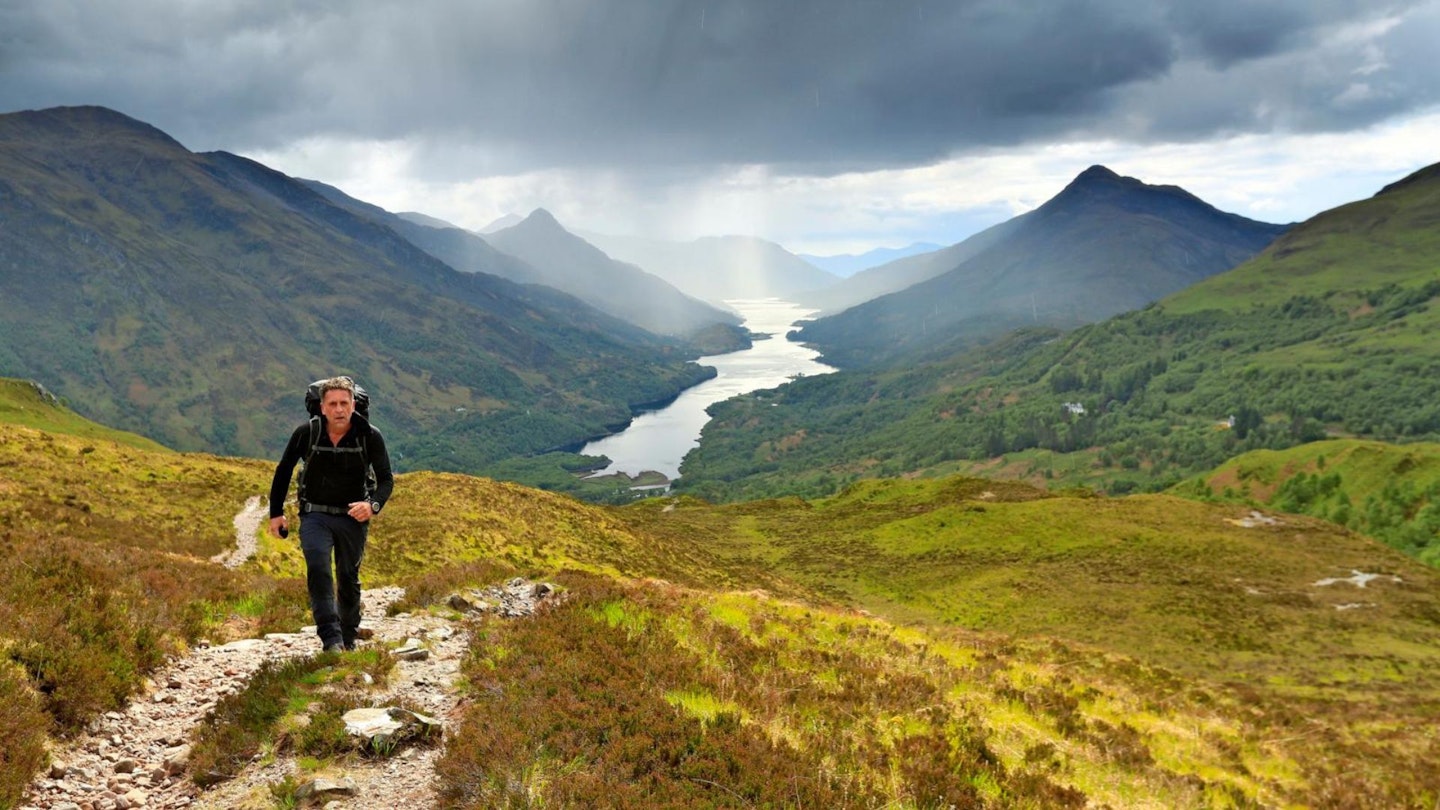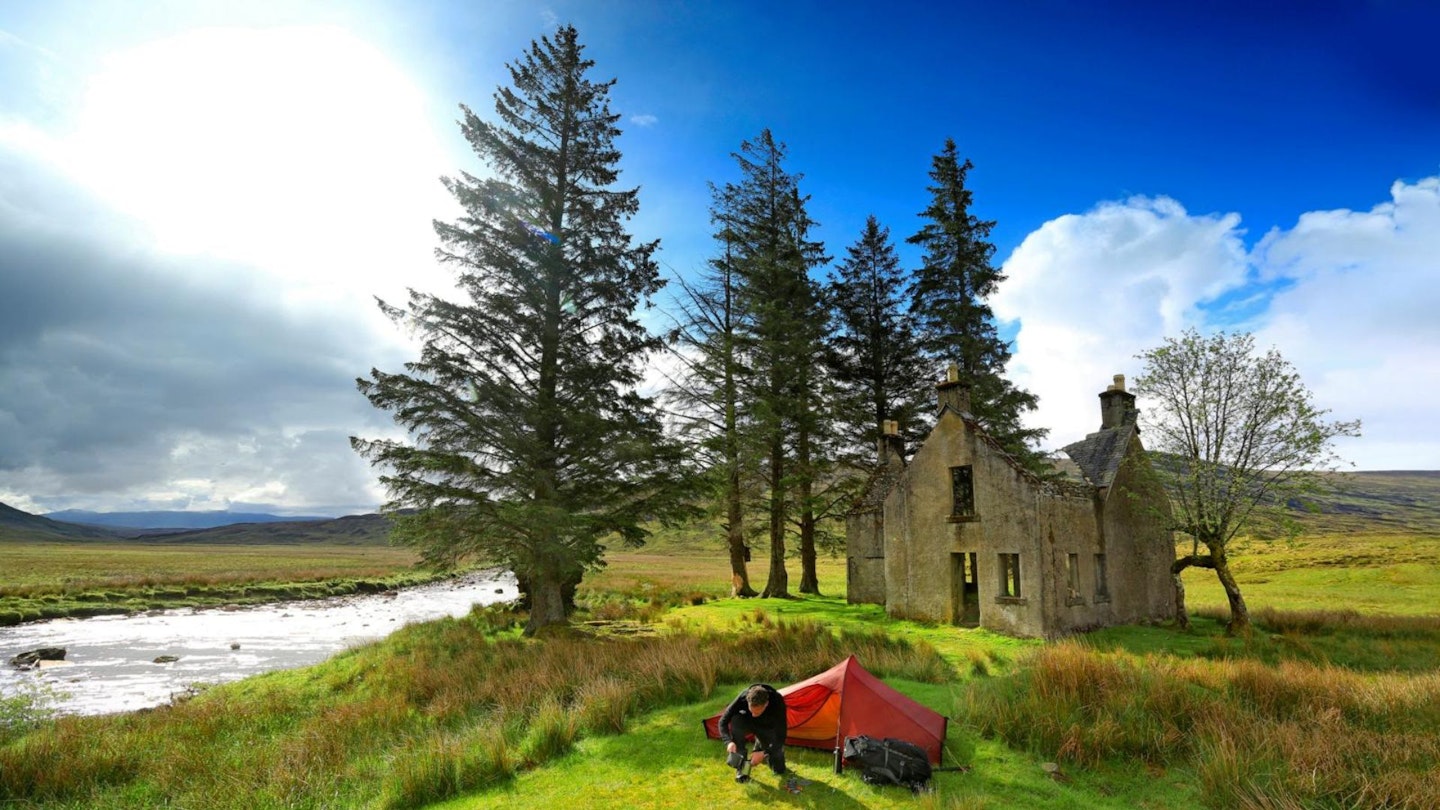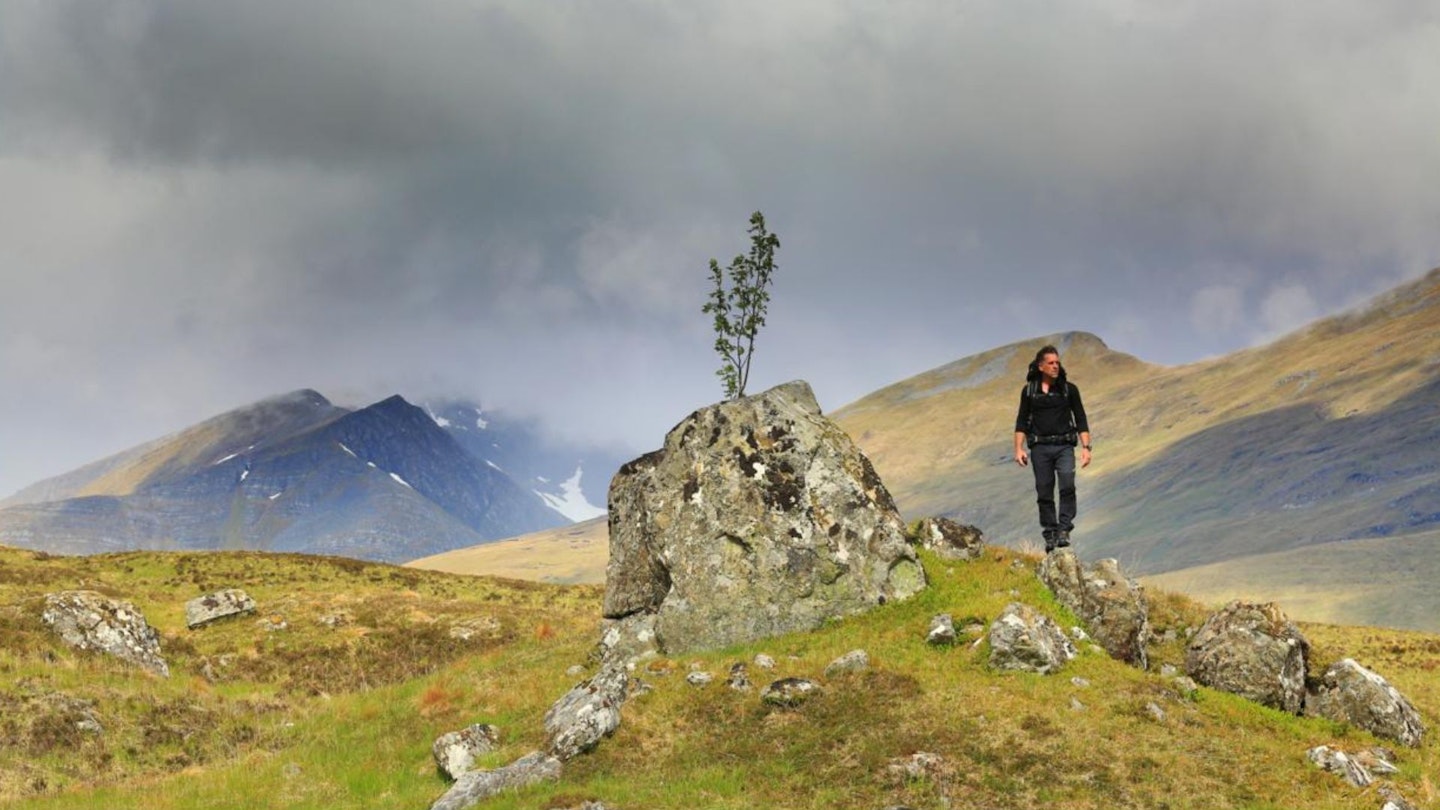I like to think I’m a relatively well-adjusted person, but I can’t resist a ghost story. Why is that? It was over the Christmas holidays, decorating a room in my house, that I first heard the Uncanny series of podcasts on BBC Sounds; short investigations into all things strange and unexplained.
Episode 10, ‘Don’t sleep in this house’, and 11, ‘The curse of Luibeilt’, was where it all started to get interesting because the story revolved around a wonderfully remote mountain landscape…
About 10km north-east of Kinlochleven, on the edge of the Mamore Forest and almost in the shadow of Ben Nevis, is a ruined two-storey house, once a deerstalker’s cottage. In the 1970s, this lonely building still had its roof, along with a resident family of hippies who unofficially lived there.
Walkers and climbers would use it like a bothy, staying over then moving on. One wintery night at the start of 1973, two climbers arrived to find the house deserted, Christmas meals still on the table, everything as it was.
They checked the house for residents but couldn’t find any. Slightly perplexed, they bedded down on the floor of the living room. Deep in the depths of the night, footsteps could be heard in the room above them.
A large pebble that one of the climbers had noticed on the upstairs room’s windowsill could be heard rolling around. A bed, dismantled and leaning against the wall in that same room, was heard being put together and dragged across the floor. The two climbers were obviously alarmed.

Then, things got crazy. In the darkness of the living room objects were flying through the air – we’re talking climbing equipment, ice axes, the works. One of the climbers could hear the other’s heart beating, they were that scared.
Then footsteps came down the staircase. In a fit of courage, one of our intrepid duo opened the stairs door at the moment the sound of the footsteps were loudest. Nothing. In the morning, the pair fled, utterly convinced there was an evil presence there.
Subsequent visits to the house by one of the climbers led to the realisation that other people were also getting freaked out here; writing had been scrawled on the walls of the house, declaring it evil and not a place to sleep in.
Some of this got into the papers back in the day. But since then, the legend of Luibeilt has largely gone the way of the house itself; it’s been forgotten and crumbled into obscurity. That was, until the podcast…
Adventuring into the unknown
Being a mountain person, I knew I had to go and visit that place, sleep there. It’s what we do isn’t it, test ourselves in this most extreme of landscapes? That being said, I lost sleep thinking about it, at the prospect of camping next to that potentially evil ruined house, so far ‘out there’, all on my own.
Then, two days before I left, a calm descended on me. I knew that because it wasn’t as it had been previously – it didn’t have a roof and was open to nature now – there couldn’t be any weirdness in there.
I’ve spent many a night under open skies and I’ve never felt afraid. I knew this would be the case. I set off on the drive, excited rather than apprehensive. After all, I had a couple of days in an area I’d only been to a few times. What more of an excuse does one need?

I re-listened to the podcasts on the long drive up, just to make sure I wasn’t forgetting how intense the original haunting had been for those involved. As a result, when I arrived at Kinlochleven, I was very ready to lose myself in this story and, of course, in the hills.
Climbing up out of the village and gaining a view down the serpent-like Loch Leven, it seemed fitting that a sky dark with menace was nearly upon me. Hail and rain followed me for the next three hours as I made my way slowly past Loch Eilde Mor, below the peak of Sgurr Eilde Mor, to ‘the house’. It was as if something didn’t want me there.
But, when I got to it, the rain stopped and a pleasant evening followed. In my mind, I’d passed the first test – I’d accepted the soaking and carried on. The rewards were proof. I wasn’t prepared for just how lovely the setting of Luibeilt is.
Hauntingly beautiful
Yes, the ruined house couldn’t look creepier if it tried. But the river, mountains, trees and glens that give it a home had done good things for it. I knew for sure that there was no evil there. There couldn’t be, right?
The walls, rendered to protect against the harsh weather, still stood, pretty much intact. All the doors and windows were gone. Dark, empty sockets took their place in that pale skull of a house.
There was no roof left. Well there was, but it was on the downstairs floor, along with fragments of chimney. The fireplace was hauntingly intact, strange writing having been inscribed on the mantle shelf; “Baz19”. What could it mean?

All this I saw as I stood by a downstairs window opening, rucksack by my feet. I wanted to take it all in, every detail, before I went about the business of putting my tent up. A flicker of life caught my eye.
There was a presence here, a female wheatear flew in, perched on some fallen masonry, looked around, then flew out through the doorway. Nature was here, haunting the place, as it haunts every nook and cranny on this planet.
A few moments later and another resident of the house put in an appearance; a mouse threaded its way over the assault course of debris; bed springs, broken crockery, litter from the many ghosthunters that come here (and who clearly don’t know how to respect ‘wild places’), and the obligatory roll of fencing wire that seems to get dumped in all abandoned buildings.
Again, the presence of that vulnerable, tiny life form took away any thoughts of a sinister nature. Then I remembered a part of the podcast that I’d not really focused on and I immediately felt sad, the colour drained out of the evening and it got cooler.
There had been a real tragedy at Luibeilt, and it’s probably the origin of the haunting, or at least, the story of the haunting. Back when the house was the deerstalker’s cottage, on presumably a large, posh estate, a deerstalker and his family lived there.

After being seen live and well earlier in the day, the deerstalker was later discovered hanging from a beam in the downstairs of the house. Life out there was clearly challenging.
During my time at Luibeilt, all 14 hours of it, I didn’t set foot in the house, partly so I didn’t disturb any nesting birds, but mostly out of respect for the life lost there.
Immediately outside of the house, between it and the river, are five or six big fir trees, adding to the gothic nature of the place. On the other side of the house is something truly magical: a rowan tree with an arched trunk. Surely two trees originally?
In the book Flora Britannica by Richard Mabey, the first line about rowan trees reads, ‘Once widely planted against houses as a protection against witches…’ Need I say more? This is clearly why that ancient, gnarled tree (or trees) is there. Did it work? Clearly not back in the 1970s, but there was a lot of very scary stuff going on then.
What is clear now, is that it lives, in a state of characterful decay, echoing the gaunt shell of the house. I passed through its arch several times for good luck…
Confronted with kindness

I felt happy as I pitched my tent and organised my little set-up. I realised I’d forgotten a lighter for my stove (even after all these years, there’s still always something forgotten…). Now, I like a bit of a problem. This one I soon worked out how to solve.
Not far from Luibeilt, about 350m, but on the other side of the Abhainn Rath (a river definitely not crossable when in a state of high water), is a real bothy, known as ‘Meanach’. Now, every bothy I’ve ever visited always has a spare lighter or matches kicking around it somewhere.
So, the river being low, I took my boots off, rolled up my trouser legs and waded over. There then followed a more challenging bog crossing, before I opened the door of the bothy to find two faces staring back at me.
I explained my presence. They helped me look for the obligatory spare lighter, alas we found none. Then, in a part of the mountains I was expecting to encounter evil, I was confronted with kindness.
One of the chaps had a spare and he gave it to me, insisting I keep it. Mountains can bring out the best in people. Thanks mate, whoever you are. So, logistical problem solved, I just had to do battle with the night and its spirits (and I don’t mean whisky, I was dry on this trip).
To be honest, now I knew that there were other humans, not half a kilometre away, it made things easier. It was late May, and at this time this far north, dusk is very late arriving and slow to turn into night.

So much so that I fell asleep while it was still light and awoke around 6am, obviously once again bathed in daylight. For all I know, ghosts could have paraded around my tent, rolled pebbles in the porch, or thrown the contents of my rucksack about – I was fast asleep. Oops!
I may have just messed up the whole trip… I’m going to take it that nothing at all happened, other than the usual cycle of day and night. There, conclusive proof ghosts don’t exist. Convinced? No, neither am I, but that was my one and only chance of finding out. Oh well.
A perfect place to live?
That fine morning, Luibeilt and its setting truly sparkled. It looked like the most perfect place to live, but it was May and the sun was shining. I’m sure come November and weeks of rain things would seem a little different.
Five or six people had stayed at Meanach bothy that night, and a few came to have a look at the old house on their way through the glen. Most had heard of the haunting. One or two were tickled to think I’d spent the night ‘ghost chasing’ (if only they knew I’d been asleep!).
I enjoyed that morning in the sun, making coffee after coffee, before breaking camp and heading for the lofty peak I’d passed on the way in; Sgurr Eilde Mor. From Luibeilt, the way to the mountain’s north-east ridge was pleasingly ‘off-path’.

Ben Nevis could be seen from an unusual perspective and I began to understand the context of where I was in relation to it. As I walked the immaculate summit ridge, storms returned, black and brooding, to dance on the grave of my overimagined fears.
I arrived at the summit at the same time as 10 minutes of intense hail. I sat, just off the top, in case lightning was on the menu, head bowed as millions of white spheres bounced off everything.
Within another 10 minutes, all had melted away. Now, that was truly amazing, just as magical as a poltergeist. Nature wasn’t finished yet.
Between my mountain and Sgurr Eilde Beag are a collection of lochans. Reflecting the blues and greys of a now clearing sky, their waters were like a mirror into another world.
As I stood, rooted to the spot by the weight of my rucksack, I suddenly heard the most haunting of cries; strangled notes of such lament, my heart wept and fled all in the same instant.
Then my rational self realised what it was. Through binoculars I could make out a red-throated diver, a bird famed for its unearthly utterances. I stood transfixed, I had eventually witnessed something otherworldly and it was much better than some silly old ghost story.
